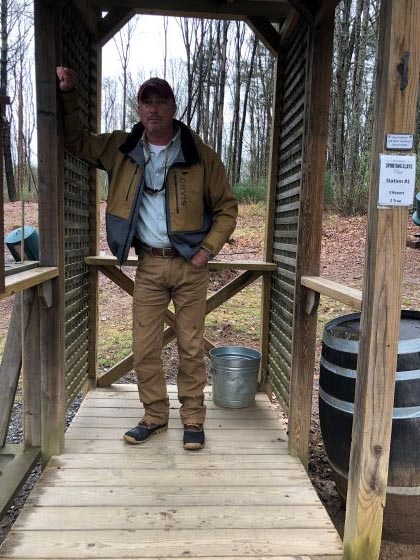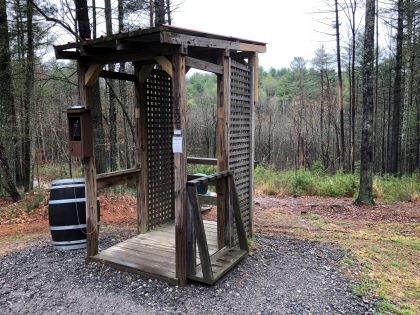Clays Shooting According to the Biltmore Estate’s Darren More: There’s No Target Breakpoint, Only Target Focus

When it comes to teaching sporting clays, Darren Moore believes that most solutions are directed at problems that don’t actually exist.
For example, he’ll tell you “People don’t build a relationship with the target, and that’s a problem. Ninety-nine percent of misses are from people thinking ‘Don’t miss the target.’ Instead, they should only focus on it.”
Getting people to build that focused relationship with the target is also one of the easiest, if not overlooked, ways to hit it.
 Darren Moore
Darren MooreDarren should know. As the Program Manager for the Biltmore Estate’s Sporting Clays School in Ashville, North Carolina, Darren has refined the solution to sporting clays consistency down to a memorable two-word meme: ultimate focus.
“There is no target breakpoint, only target focus,” he says. “There’s never a where, only a when.”
While that may sound like heresy, Darren has effectively created a jargon that instructors like him must use on the job. I’ve taken plenty of lessons over the years, but I always found that clays shooting instructors at resorts have the best approach to simplifying the core basics. That’s because they are confronted every day with brand new shooters, many of whom never held a shotgun before, and it’s the instructor’s job to get the guest breaking targets within, let’s say, a one-hour session.
That means there’s little time to wax poetic about eye-dominance, break points and gun fit, among a boxcar full of other shotgunning tenets that you’ll pay a small fortune to learn from high-profile instructors. At the Biltmore Estate, a clays lesson has to be easy to digest and provide a high level of satisfaction. Hence, ultimate focus.
 The historic estate house at the Biltmore Estate.
The historic estate house at the Biltmore Estate.“I want to deal with the base level, where everyone is using their pre-existing skills,” Darren explains. “And instinctive shooting is a pre-existing skill. It’s not a matter of right versus wrong. It’s easy versus hard. It’s in your head.”
His instructional technique is a blend of the tactical shooting he employed in the military and law enforcement combined with the widely accepted Churchill approach to teaching wingshooting and sporting clays.
As Darren would agree, most of the people he instructs at the Biltmore Estate never heard of the Churchill Method (or think it’s something conjured up by the late British Prime Minister). In fact, it was developed by Englishman Robert Churchill. He wrote a book about his method called “Game Shooting: A Textbook on the Successful Use of the Modern Shotgun,” originally published in 1955 with several updates since by his biographer Macdonald Hastings.
 Robert Churchill’s classic “Game Shooting: A Textbook on the Successful Use of the Modern Shotgun.”
Robert Churchill’s classic “Game Shooting: A Textbook on the Successful Use of the Modern Shotgun.”As widely circulated over the decades, often misunderstood and taken out of context, the Churchill Method advocated that if you focus on the front of the bird and your technique is good, your eyes will make the necessary forward allowance and instinctively put the shotgun in the right place for the kill.
As Darren elucidates, “You don’t need lead. Lead is a self-perpetuating problem. What we’re looking for is a pure method of instinctive shooting. The Churchill Method goes hand in hand with instinctive shooting. If you keep your eyes on the target your hands will follow. If you have focus, your hands can’t fail. We’re taking that approach here.”
Darren also proposes that having a shotgun custom fitted to you is a somewhat overblown assumption. “A fitted gun becomes less important if you’re truly shooting with complete hand-eye coordination.”
 One of the stands on the Biltmore Estate’s Vineyard sporting clays course.
One of the stands on the Biltmore Estate’s Vineyard sporting clays course.Darren and I are on the Biltmore Estate’s Vineyard Sporting Clays Course and I’m getting ready to put his “ultimate focus” to the test as I step into the number-six stand with my shotgun. The Vineyard Course is designed for basic to intermediate shooters. The Biltmore’s Woodland Course is more difficult because it throws longer targets. As an aside, Darren and his team also rely on an instructional 5-stand popular with corporate shoots and other groups. There’s a combined skeet-trap field as well.
Before I call for the target he asks, “What’s your job?”
“Break the target,” I answer.
“Your intention of breaking the target is worthless,” he says. “Your job is perfect focus. It’s one task. This is simple.”
 The hallway of the Biltmore Estate shooting club’s building.
The hallway of the Biltmore Estate shooting club’s building.Station 6 is an easy incomer, but it really illustrates the premise of ultimate focus because it allows your eyes enough time to zone in on the leading edge of the target.
He tells me, “The target (visual) pick-up point is where you see the target. It should not be separate from the hold point. Traditionally, the hold point is behind the pick-up point. The pick-up point and the hold point are the same.”
As we move through some other stations on the Vineyard Course, it becomes apparent that the presentations tend to be slow and close. It’s the low velocity, I’m finding, that can trip up ultimate focus, because it can be trying to hold your concentration long enough along the target trajectory to break it at the sweet spot.
 The classroom in the Biltmore Estate’s shooting club house.
The classroom in the Biltmore Estate’s shooting club house.I’m learning that the eyes will develop focus as the shot develops. As I watch a couple of lookers, Darren shows me initially how you see a big picture of the target, but then you have to narrow it onto the leading edge of the target.
“Focus comes and goes,” he explains. “You can’t hold focus. You must have confidence in your hands and eyes and the focus. When you get the focus, you have to trust it. You can’t debate focus. When you’re there, deal with it.”
Irwin Greenstein is the publisher of Shotgun Life. You can reach him at contact@shotgunlife.com.
Useful resources:

Irwin Greenstein is Publisher of Shotgun Life. Please send your comments to letters@shotgunlife.com.


Comments